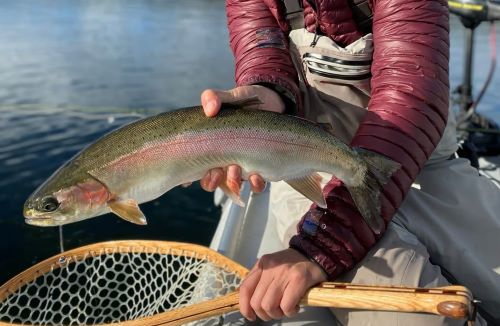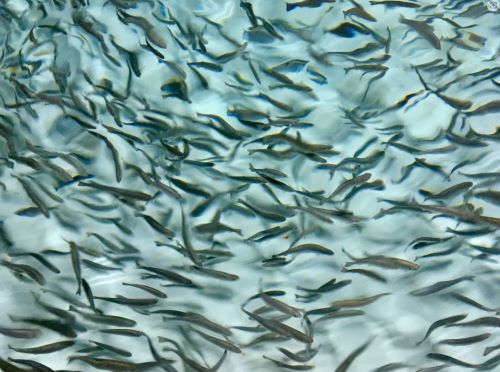Publish date: November 16, 2018
Each spring and fall, Freshwater Fisheries Society of BC fish culturists live-trap trout, char, and kokanee that are ready to spawn from one of nine egg-collection sites around the province. One-by-one, hatchery staff collect gametes (eggs and milt/sperm) to spawn the next generation of fish. This is part of a blog series where we explore the origin of the catch at the end of your line.
So, you’ve caught a Pennask rainbow trout – where did that fish come from?
The Pennask strain of rainbow trout are originally from Pennask Lake, where the adult spawners were caught in Pennask Creek. This system has been used as a permanent egg-collection station since 1927 and has never been stocked, so the origin of these fish is truly wild.
Your fish was stocked into the lake in which you caught it when it was a fry or yearling. Before that, she was once a fertilized egg that grew into a fry and thrived at our Summerland Trout Hatchery.
Wait… “she?” How do you know?
The Freshwater Fisheries Society produces all-female rainbow trout, helping to reduce genetic risks to wild stocks, and improving the fishery for anglers. Although rainbow trout can spawn more than once, many fish don’t survive after spawning to do so. Because females are less likely to mature precociously (mature early), and because sterilized (triploid) females put all of their energy into body growth, stocking only females increases the number of big fish available for anglers to catch. Plus, in systems where we want to manage for a consistent trout population, stocking only females results in no natural reproduction.

Where did this fish’s parents live?
Your Pennask rainbow trout’s mom, or grandmother, was a wild Pennask Lake female trout and her “dad” was a hatchery sex-reversed female. In this way, stocked Pennask rainbow trout maintain very similar genetics and characteristics to their wild ancestors.
Hold on…did you say “sex-reversed?”
That’s right. Fish species tend to be very plastic in their development, meaning that they can mature to look and act like a male even if they are genetically female. This is an example of sex-reversal. We use this trait to breed wild females with captive sex-reversed females (who produce sperm), to produce all-female offspring. As described above, stocking all females can result in an improved fishery.
Your fish’s mom, or grandma, was caught in a creek trap at Pennask Creek, and her eggs were collected on-site. This egg collection happens only after thousands of females have been passed upstream to ensure a sustainable, abundant wild population. The eggs are then transported to the Summerland Trout Hatchery, and fertilized using milt from sex-reversed females. The offspring hatch and grow here, or at another one of our hatcheries, and are then stocked into Interior lakes. A small number of these offspring are raised as broodstock to be stocked into Beaver and Dee lakes, or kept in the hatchery as sex-reversed female broodstock.
If the grandmother of this fish was the one whose eggs were collected at Pennask Lake, then this fish’s mom was from the Beaver or Dee Lake broodstock population. Egg collection at these lakes happens earlier than the Pennask Lake spawning, allowing extra time for these offspring to grow. These additional broodstocks also relieve pressure on the wild Pennask Lake population. Spawning occurs onsite at the Summerland Trout Hatchery, where these eggs will be fertilized and reared just like those from Pennask Lake.
What happens next?
Back at the hatchery, the dad’s milt was mixed with the mom’s eggs to fertilize the eggs. After this process, the fertilized eggs were moved to the incubation room. The incubated eggs would all hatch and grow up into fry at the hatchery. Pennask fry, just like these, are stocked into lakes across the province. After a year of growth in the lake, they will develop into catchable-sized trout, and could end up on your hook.

What lakes are stocked with Pennask trout?
Every year, our hatcheries raise and release over six million trout, char, and kokanee – from juvenile fry to catchable-sized fish. To see where we stock the Pennask strain of rainbow trout, use the Detailed Stocking Report tool, and filter by Pennask under Stock Strain. And to learn more about the unique traits of the species and strains we stock, including their origin, and habitat preferences – as well as tips to help you fish – visit the Stocked Strains section of our website.
Author: Freshwater Fisheries Society of BC Staff